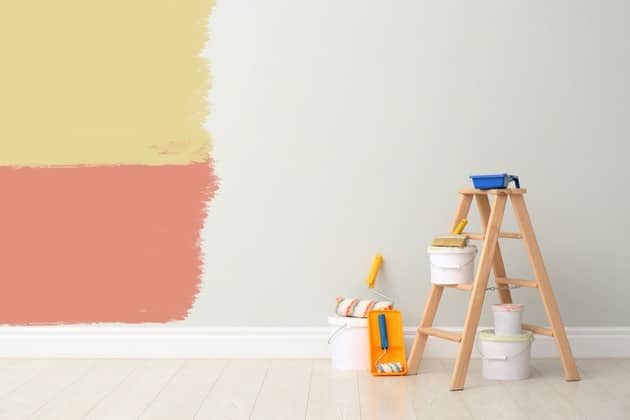How to Start a Handyman Business: Startup Checklist
Do you have a steady hand, an eye for detail, and a dream to brush aside the daily 9-to-5? A painting business might be the perfect outlet for your creativity and ambition.
Starting a painting business comes with benefits like low startup costs and the ability to be your own boss. It’s a smart move if you’re looking to combine creativity and entrepreneurship.
In this guide, we’ll cover step-by-step instructions on how to start a painting business. You’ll learn everything you need to know to begin a thriving career.
Top 6 Benefits of Starting a Painting Business
From the high earnings to the even higher demand, there are many good reasons to start a commercial painting business.
Here are six of the most compelling:
- Low Startup Costs. You don’t need much to get a painting business off the ground. Some basic equipment like brushes, rollers, and ladders is enough.
- Potential for Growth. As your business takes off, you have the option to expand by hiring employees or subcontractors. This lets you take on bigger projects and increase your revenue. You can grow your business as much or as little as you feel comfortable with.
- Steady Demand. People always need painting services for their homes and businesses. This constant demand means you can build a steady stream of potential customers. And since buildings need fresh paint periodically, many will become repeat clients.
- Being Your Own Boss. With your own painting business, you’re in charge. You get to decide which jobs to take and set your own schedule. For many, independence and flexibility are major perks of being self-employed.
- Expressing Your Creativity. Painting is a skilled trade that lets you tap into your artistic side. You get to help clients choose colors and finishes to transform their spaces. And seeing the results of your work is rewarding.
- Specializing for Higher Earnings. You can boost your income by specializing in high-end painting finishes and techniques. Discerning customers will pay top dollar for services like faux finishes and historic home painting.
RELATED ARTICLE — How To Write a Paint Job Invoice (With Free Template)
How To Start a Painting Business in 7 Steps

Here’s a breakdown of what you need to do to launch your business:
1. Learn Professional Painting Techniques
Starting a painting business with no experience isn’t a recipe for success. To deliver quality results, you first have to learn a few techniques:
- Surface Preparation. Scraping, patching, and sanding surfaces before painting is crucial for a flawless finish.
- When To Prime. Using a primer before painting is important for most projects, except for small touch-ups and refreshes.
- Paint Types. Oil-based, latex, and other specialty paints all have different uses. Knowing which one to apply when lets you tackle any project.
- Tools and Materials. Use high-quality equipment for the best results. Find brands you like that balance affordability with quality.
- Different Painting Techniques. Learn about methods like cutting in, stippling, and ragging. Developing various skills takes your services to the next level.
- Proper Paint Application. Applying paint smoothly and evenly from top to bottom takes practice. But it’s key to avoiding drips, streaks, and missed spots.
2. Complete Business Registration
Before booking clients, make your business official. You need to register your company with the right government agencies so everything is above board. The process of formally starting a business varies by location but usually includes the following:
- Coming up with a memorable name
- Choosing a business structure (sole proprietorship, partnership, LLC)
- Registering with your state or local government and getting a tax ID number
- Getting any required licenses and permits, such as a business license
3. Get Insurance
Accidents happen, even when you’re careful. Insurance helps you avoid unexpected costs that could create financial difficulties.
Key types of insurance to consider include:
- General Liability Insurance. This covers property damage and injuries that happen on the job. It can help pay for legal fees and medical expenses.
- Workers’ Compensation Insurance. In most states, this coverage is mandatory if you have employees. It provides benefits if a worker gets injured or sick while working for you.
- Commercial Auto Insurance. Personal auto policies usually don’t cover business use. If you use a vehicle for your painting business, you need this coverage in case of accidents.
- Equipment Insurance. Replacing expensive equipment can be a major financial setback. Equipment insurance protects your painting gear in case of theft, damage, or loss.
4. Open a Separate Business Bank Account
Opening a dedicated business bank account helps you separate personal from professional. It also protects your assets if you run into financial or legal issues. Plus, a business account appears more professional to clients. And some banks offer perks like access to lines of credit.
5. Purchase Painting Equipment
When it comes to equipment, what do you need to start a painting business? It depends on your main activities.
Here’s a list of key items you may need:
- Brushes in different sizes
- Rollers and covers
- Extension poles
- Paint sprayer
- Drop cloths (made from canvas or other durable material)
- A sturdy ladder
- Paint trays
- Caulk and putty or compound
- Sandpaper and sanding blocks
- Scrapers
- Painter’s tape
- Safety gear (gloves, masks, glasses)
- Industrial primer
- Pressure washer
- Tape measure
- Stir sticks
- Edging tools
If you’re just painting residential homes in the neighborhood, you might only need rollers, trays, and drop cloths. Buy more as your business grows.
6. Set Your Prices
Pricing your services is a balancing act between staying competitive and making a profit. Here are some tips for mastering your pricing strategy:
- Research the Market. Look at what painting companies in your area are charging for similar services. This gives you a baseline for setting your own prices.
- Calculate Your Costs. Add up all of your business expenses. This includes materials, labor, and overhead. Make sure your prices cover the costs and leave room for profit.
- Be Transparent with Clients. Clearly communicate your pricing structure and what’s included in each service package. It helps to offer a simple contract or statement of work so everyone is on the same page.
Remember to review and adjust your overall pricing strategy regularly. You should always be ready to adapt based on market conditions and your business goals.
When pricing individual jobs, follow these steps:
- Assess the space and estimate how much time you’ll need to complete the project.
- Calculate labor costs by multiplying the estimated hours by your hourly rate.
- Account for materials, overhead expenses, and your target profit margin.
- Add up all the costs to calculate the total price for the job.
- Use software to create a professional, detailed quote and send it to the client for review and approval.
RELATED ARTICLE — How To Estimate a Paint Job (w/ writing tips & Free Template)
7. Consider Hiring Subcontractors or Employees
As your painting business grows, you may find that you need some extra help to finish jobs efficiently. Hiring subcontractors or employees lets you take on more projects and expand your services.
Here are some things to consider when deciding whether to bring on additional help:
- Workload. If you’re turning down jobs or struggling to meet deadlines, it may be time to check out the hiring market.
- Skills. Subcontractors or employees with specialized skills let you offer higher-end services.
- Cost. Factor in the cost of hiring, training, and managing additional workers. Make sure your business can support the added expenses.
- Reliability. Hire people you can trust to show up on time, do quality work, and represent your business well.
Expanding your team can be a great way to grow your painting business, but weigh the pros and cons first to avoid biting off more than you can chew. Make sure you have the resources and systems in place to manage additional workers.
RELATED ARTICLE — How To Ask for Deposits as a Residential Contractor (+ Samples)
5 Growth Tips for Your Painting Business

Now that you’ve learned how to run a successful painting business, it’s time to focus on growth. Here are some tips to help you expand your customer base and increase your revenue:
- Develop a Strong Online Presence. Create a professional website showcasing your services, portfolio, and customer reviews. It helps to use social media to connect with potential clients and share your work.
- Network With Other Professionals. Build relationships with other business owners who can refer people to you. In return, you can recommend their businesses to your clients. Related professionals might include contractors, interior designers, or real estate agents. Attend local business events and join industry associations to meet potential partners.
- Expand Your Services. Consider adding complementary services like wallpaper installation, cabinet painting, or exterior pressure washing. This can attract new customers and increase your value to existing ones.
- Invest in Marketing. Set aside a portion of your budget for advertising. If you have a niche, like painting homes being staged for sale, develop campaigns that target specific neighborhoods or demographics.
- Embrace Technology. Use project management software, online invoicing, and digital color visualizers to streamline your operations and provide a better customer experience.
RELATED ARTICLE — How To Follow Up on an Estimate (with Email Templates)
Win More Clients On-The-Spot With Quick and Professional Estimates
Making estimates is an indispensable part of running your own painting business. Joist makes it painless and professional.
With Joist, you can create and share estimates in just minutes with an easy-to-use mobile estimating tool. It’s packed with powerful features built for contractors, including deposits, markups, and contracts. Put it on your business to-do list.